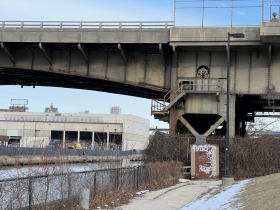Milwaukee Losing One Of Its Movable Bridges
16th Street Bridge will be rebuilt as stationary structure.
One of Milwaukee’s 21 movable bridges will soon stop opening.
The 16th Street Bascule Bridge over the Menomonee River will be rebuilt as a stationary structure. The $15 million project will replace the 384-foot bascule section of the 0.8-mile-long James E. Groppi Unity Bridge (formerly the 16th Street Viaduct) that runs from W. Clybourn St. to W. Pierce St. over the Menomonee Valley.
There will be no grand final opening. In fact, the bascule bridge last moved approximately two decades ago. “According to employees who were around at the time they believe the bridge was operated several times a year until the early 2000s. Our bridge inspection reports list the bridge as operable until 2007,” said a Department of Public Works spokesperson via email. The viaduct structure dates back to 1929 and was last rehabilitated in 1986.
Recreational boaters need not fret about the loss of a navigable waterway. The structure, according to the Federal Register, has a 35-foot clearance above normal water levels.
The portion of the river west of the 56-foot-wide bridge is no longer part of the federally-governed shipping channel. “The City worked with Wisconsin’s federal representatives to have the federal channel deauthorized as part of the 2018 Water Resources Development Act,” said DPW in a statement. “The final step of the process will be to apply for a new bridge permit from the U.S. Coast Guard that will define the permanent clearances at the bridge. This will be done as part of the design phase of the planned rehab.”
Construction, according to a 2022 budget document, is to occur in 2025. State and federal funding are covering approximately 80% of the project costs.
The channel designation previously extended west to the fixed 25th St. Bridge. Industrial users in that area have been replaced, with pleasure crafts now heading to City Lights Brewing instead of coke-laden ships bound for what once was a city lighting complex. A 1937 aerial image shows both sides of the river lined with large piles.
The viaduct is listed on the State Register of Historic Places, so its rehabilitation may not include much in the way of visual change. The bridge house on the structure could be maintained if it’s deemed a contributing element to the designation. But the 79-span viaduct is on the register primarily for its social significance. In the late 1960s, it was a key passageway on many fair housing marches, led by father James Groppi and the youth council of the NAACP, that went from the predominantly Black north side to the predominately white south side. “The viaduct serves as a reminder that human rights are rarely granted without a struggle,” says the state listing.
Historical bridge opening records provided by DPW, covering 1967 to 1985, show the bridge opening only a few dozen times per year in the 1980s after peaking at 421 in 1974. In 2021, the city reported 27,769 citywide bridge openings, driven primarily by pleasure crafts and tour boats along the Milwaukee River Downtown.
Milwaukee’s Movable Bridge Ranking
Even after removing a movable bridge from its inventory, Milwaukee will remain the city with the third-most movable bridges in the country. Chicago is safely in first place with 37. New York City’s Department of Transportation reports 24 movable bridges. It’s tough to discern Milwaukee’s world ranking, but it was already one behind Saint Petersburg, Russia (22).
Complicating any measure of counting the bridges is the unofficial way the movable bridges are counted. Milwaukee’s 20 movable bridges are all owned and operated by the Department of Public Works, but there are another five railroad bridges that move. That includes a Canadian Pacific bridge over the Burnham Canal that is welded shut and requires a one-year notice to open as well as the Union Pacific swing bridge between the Historic Third Ward and Walker’s Point that isn’t connected to the railroad network anymore.
History buffs will note this isn’t the first time in recent decades that Milwaukee has lost a movable bridge. There was previously a bridge at E. Buffalo St. over the Milwaukee River. The city gained a movable bridge in the early 2000s when McKinley Avenue Lift Bridge was built after the Park East Freeway came down.
In addition to the 16th Street Bridge, Milwaukee is pursuing the rehabilitation of the Cherry Street Bridge.
Photos
Update: An earlier version of this article undercounted the number of moving railroad bridges.
If you think stories like this are important, become a member of Urban Milwaukee and help support real, independent journalism. Plus you get some cool added benefits.
Transportation
-
Congestion Pricing Cuts Air Pollution in New York City
 Dec 14th, 2025 by Jeff Wood
Dec 14th, 2025 by Jeff Wood
-
FTA Tells Milwaukee to Crack Down on Fare Evasion — Even Where Fares Don’t Exist
 Dec 12th, 2025 by Graham Kilmer
Dec 12th, 2025 by Graham Kilmer
-
Will GOGO’s Bus Service Ever Get Going?
 Dec 9th, 2025 by Jeramey Jannene
Dec 9th, 2025 by Jeramey Jannene




























